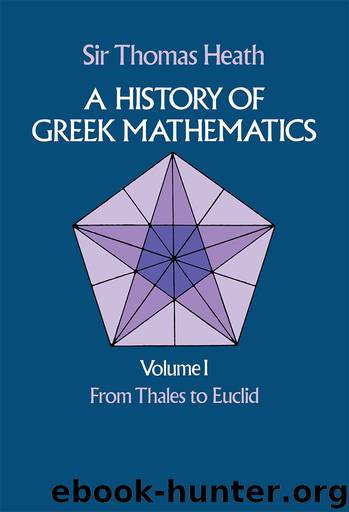A History of Greek Mathematics Volume 1 by Sir Thomas Heath

Author:Sir Thomas Heath
Language: eng
Format: epub
Publisher: Dover Publications, Inc.
Published: 2013-06-26T16:00:00+00:00
The squaring of the circle.
There is presumably no problem which has exercised such a fascination throughout the ages as that of rectifying or squaring the circle; and it is a curious fact that its attraction has been no less (perhaps even greater) for the non-mathematician than for the mathematician. It was naturally the kind of problem which the Greeks, of all people, would take up with zest the moment that its difficulty was realized. The first name connected with the problem is Anaxagoras, who is said to have occupied himself with it when in prison.6 The Pythagoreans claimed that it was solved in their school, ‘as is clear from the demonstrations of Sextus the Pythagorean, who got his method of demonstration from early tradition’7; but Sextus, or rather Sextius, lived in the reign of Augustus or Tiberius, and, for the usual reasons, no value can be attached to the statement.
The first serious attempts to solve the problem belong to the second half of the fifth century B.C. A passage of Aristophanes’s Birds is quoted as evidence of the popularity of the problem at the time (414 B.C.) of its first representation. Aristophanes introduces Meton, the astronomer and discoverer of the Metonic cycle of 19 years, who brings with him a ruler and compasses, and makes a certain construction ‘in order that your circle may become square’.8 This is a play upon words, because what Meton really does is to divide a circle into four quadrants by two diameters at right angles to one another; the idea is of streets radiating from the agora in the centre of a town; the word ττράγωνος then really means ‘with four (right) angles’ (at the centre), and not ‘square’, but the word conveys a laughing allusion to the problem of squaring all the same.
We have already given an account of Hippocrates’s quadratures of lunes. These formed a sort of prolusio, and clearly did not purport to be a solution of the problem; Hippocrates was aware that ‘plane’ methods would not solve it, but, as a matter of interest, he wished to show that, if circles could not be squared by these methods, they could be employed to find the area of some figures bounded by arcs of circles, namely certain lunes, and even of the sum of a certain circle and a certain lune.
Download
This site does not store any files on its server. We only index and link to content provided by other sites. Please contact the content providers to delete copyright contents if any and email us, we'll remove relevant links or contents immediately.
Modelling of Convective Heat and Mass Transfer in Rotating Flows by Igor V. Shevchuk(6222)
Weapons of Math Destruction by Cathy O'Neil(5829)
Factfulness: Ten Reasons We're Wrong About the World – and Why Things Are Better Than You Think by Hans Rosling(4487)
Descartes' Error by Antonio Damasio(3164)
A Mind For Numbers: How to Excel at Math and Science (Even If You Flunked Algebra) by Barbara Oakley(3103)
Factfulness_Ten Reasons We're Wrong About the World_and Why Things Are Better Than You Think by Hans Rosling(3046)
TCP IP by Todd Lammle(3012)
Applied Predictive Modeling by Max Kuhn & Kjell Johnson(2907)
Fooled by Randomness: The Hidden Role of Chance in Life and in the Markets by Nassim Nicholas Taleb(2860)
The Tyranny of Metrics by Jerry Z. Muller(2846)
The Book of Numbers by Peter Bentley(2779)
The Great Unknown by Marcus du Sautoy(2536)
Once Upon an Algorithm by Martin Erwig(2473)
Easy Algebra Step-by-Step by Sandra Luna McCune(2467)
Lady Luck by Kristen Ashley(2410)
Practical Guide To Principal Component Methods in R (Multivariate Analysis Book 2) by Alboukadel Kassambara(2379)
Police Exams Prep 2018-2019 by Kaplan Test Prep(2355)
All Things Reconsidered by Bill Thompson III(2261)
Linear Time-Invariant Systems, Behaviors and Modules by Ulrich Oberst & Martin Scheicher & Ingrid Scheicher(2231)
